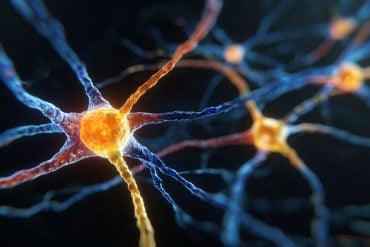Summary: Researchers link the Human Herpes Virus 6A to the development of multiple sclerosis.
Source: Karolinska Institute
Researchers at Karolinska Institutet have developed a new method to separate between two different types of a common herpes virus (HHV-6) that has been linked to multiple sclerosis. By analyzing antibodies in the blood against the most divergent proteins of herpesvirus 6A and 6B, the researchers were able to show that MS-patients carry the herpesvirus 6A to a greater extent than healthy individuals. The findings, published in Frontiers in Immunology, point to a role for HHV-6A in the development of MS.
Multiple sclerosis, MS, is an autoimmune disease that affects the central nervous system. The cause of the disease is unclear, but one plausible explanation is a virus tricks the immune system to attack the body’s own tissue. Human Herpesvirus 6 (HHV-6) has previously been associated with MS, but in those studies, it wasn’t possible to distinguish between 6A and 6B. Through virus isolation from ill individuals, researchers have been able to show that HHV-6B can cause mild conditions such as roseola in children, but it has been unclear if HHV-6A is the cause of any disease.
According to estimates, as many as 80 percent of all children are infected with the HHV-6 virus before 2 years of age, and many also carry protection in the form of antibodies against this particular virus for the rest of their lives. But since it hasn’t been possible to tell the two variants apart post-infection, it has been difficult to say whether HHV-6A or B is a risk factor for MS.
In this study, however, the researchers were able to distinguish between the A and B virus by analyzing antibodies in the blood against the proteins–immediate early protein 1A and 1B (IE1A and IE1B)–that diverge the most between the two viruses.
“This is a big breakthrough for both the MS and herpes virus research,” says Anna Fogdell-Hahn, associate professor at the Department of Clinical Neuroscience at Karolinska Institutet and one of the study’s senior authors. “For one, it supports the theory that HHV-6A could be a contributing factor to the development of MS. On top of that, we are now able, with this new method, to find out how common these two different types of HHV-6 are, something we haven’t been able to do previously.”
The researchers compared antibody levels in blood samples of some 8,700 MS-patients against more than 7,200 healthy people whose gender, date of birth, date of blood sample and other factors matched those with MS. They concluded that people with MS had a 55 percent higher risk of carrying antibodies against the HHV-6A protein than the control group. In a sub-group of almost 500 people, whose blood samples were drawn before the onset of the disease, the risk of developing MS in the future was more than doubled if they had a 6A viral infection. The younger the people were when the virus was first discovered in the blood, the higher the risk was of developing MS in the future. HHV-6B, on the other hand, was not positively associated with MS. Instead MS-patients had lower levels of antibodies toward IE1B than those without MS.

Antibodies toward Epstein-Barr virus (EBV), another herpes virus that is also associated with MS, were analyzed with the same method and the researchers were able to show that individuals affected with both viruses had an even greater risk of MS. This indicates that several virus infections could be acting jointly to increase the risk of MS.
“Both HHV-6A and 6B can infect our braincells, but they do it in slightly different ways. Therefore, it is now interesting to go forward and attempt to map out exactly how the viruses could affect the onset of MS,” says Anna Fogdell-Hahn.
Funding: The research has been financed by grants from the Swedish Research Council, Stockholm County Council, Swedish Brain Foundation, KAW Foundation, Margareta af Ugglas Foundation, MultipleMS Horizon 2020, Multiple Sclerosis Society of Canada and the Swedish Society of Medical Research. Some of the researchers have previously received grants/fees by pharmaceutical companies in various contexts. See full scientific article for further information.
Source:
Karolinska Institute
Media Contacts:
Press Office – Karolinska Institute
Image Source:
The image is credited to UPF.
Original Research: Open access
“Increased Serological Response Against Human Herpesvirus 6A Is Associated With Risk for Multiple Sclerosis”. Anna Fogdell-Hahn et al.
Frontiers in Immunology doi:10.3389/fimmu.2019.02715.
Abstract
Increased Serological Response Against Human Herpesvirus 6A Is Associated With Risk for Multiple Sclerosis
Human herpesvirus (HHV)-6A or HHV-6B involvement in multiple sclerosis (MS) etiology has remained controversial mainly due to the lack of serological methods that can distinguish the two viruses. A novel multiplex serological assay measuring IgG reactivity against the immediate-early protein 1 from HHV-6A (IE1A) and HHV-6B (IE1B) was used in a MS cohort (8,742 persons with MS and 7,215 matched controls), and a pre-MS cohort (478 individuals and 476 matched controls) to investigate this further. The IgG response against IE1A was positively associated with MS (OR = 1.55, p = 9 × 10−22), and increased risk of future MS (OR = 2.22, p = 2 × 10−5). An interaction was observed between IE1A and Epstein-Barr virus (EBV) antibody responses for MS risk (attributable proportion = 0.24, p = 6 × 10−6). In contrast, the IgG response against IE1B was negatively associated with MS (OR = 0.74, p = 6 × 10−11). The association did not differ between MS subtypes or vary with severity of disease. The genetic control of HHV-6A/B antibody responses were located to the Human Leukocyte Antigen (HLA) region and the strongest association for IE1A was the DRB1*13:01-DQA1*01:03-DQB1*06:03 haplotype while the main association for IE1B was DRB1*13:02-DQA1*01:02-DQB1*06:04. In conclusion a role for HHV-6A in MS etiology is supported by an increased serological response against HHV-6A IE1 protein, an interaction with EBV, and an association to HLA genes.






